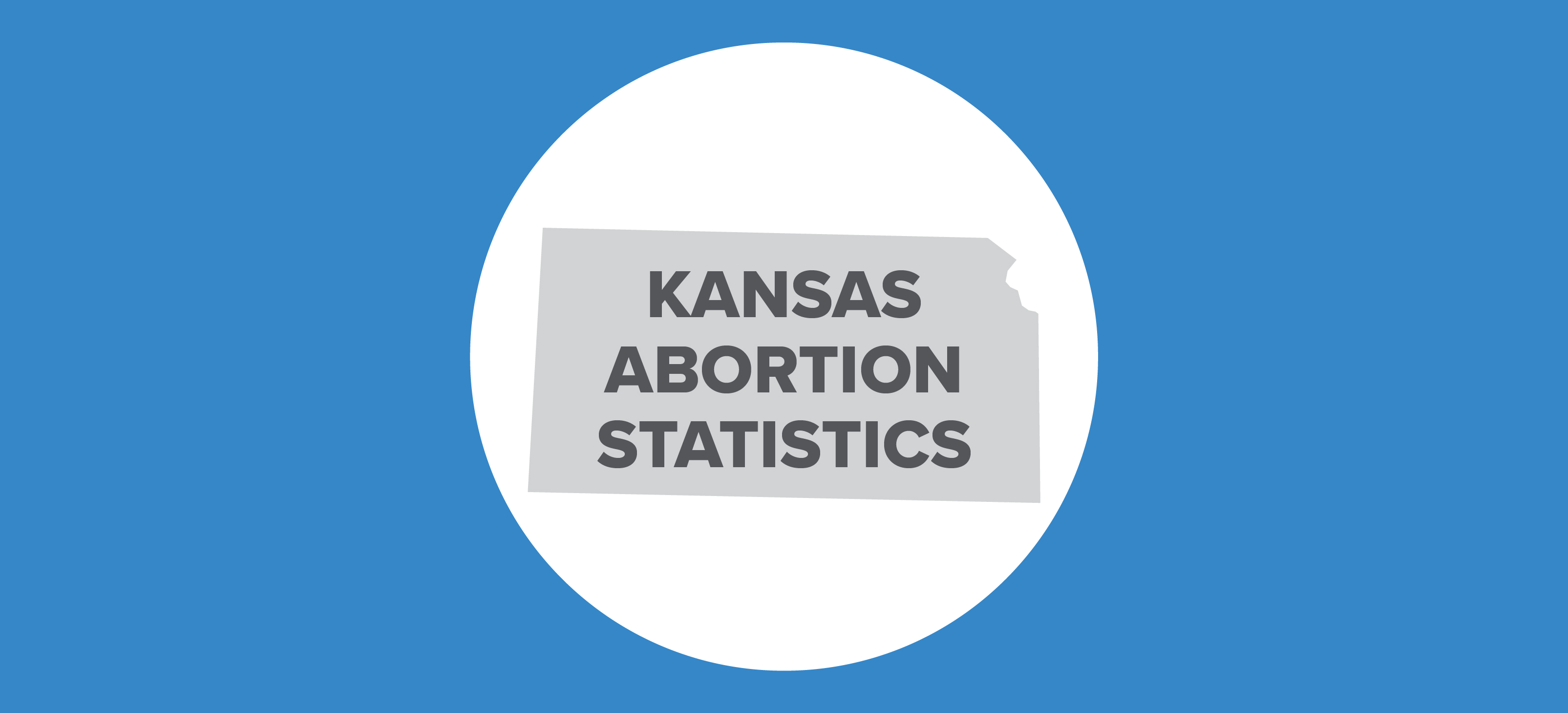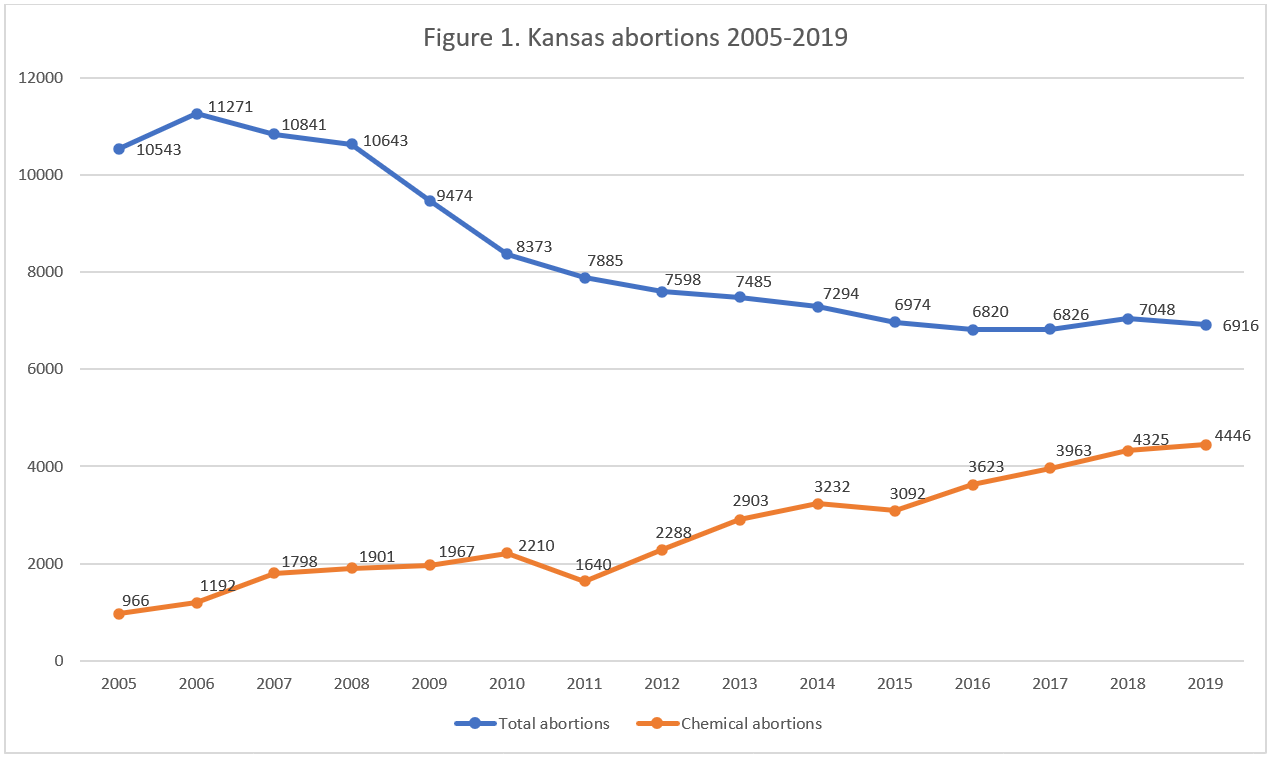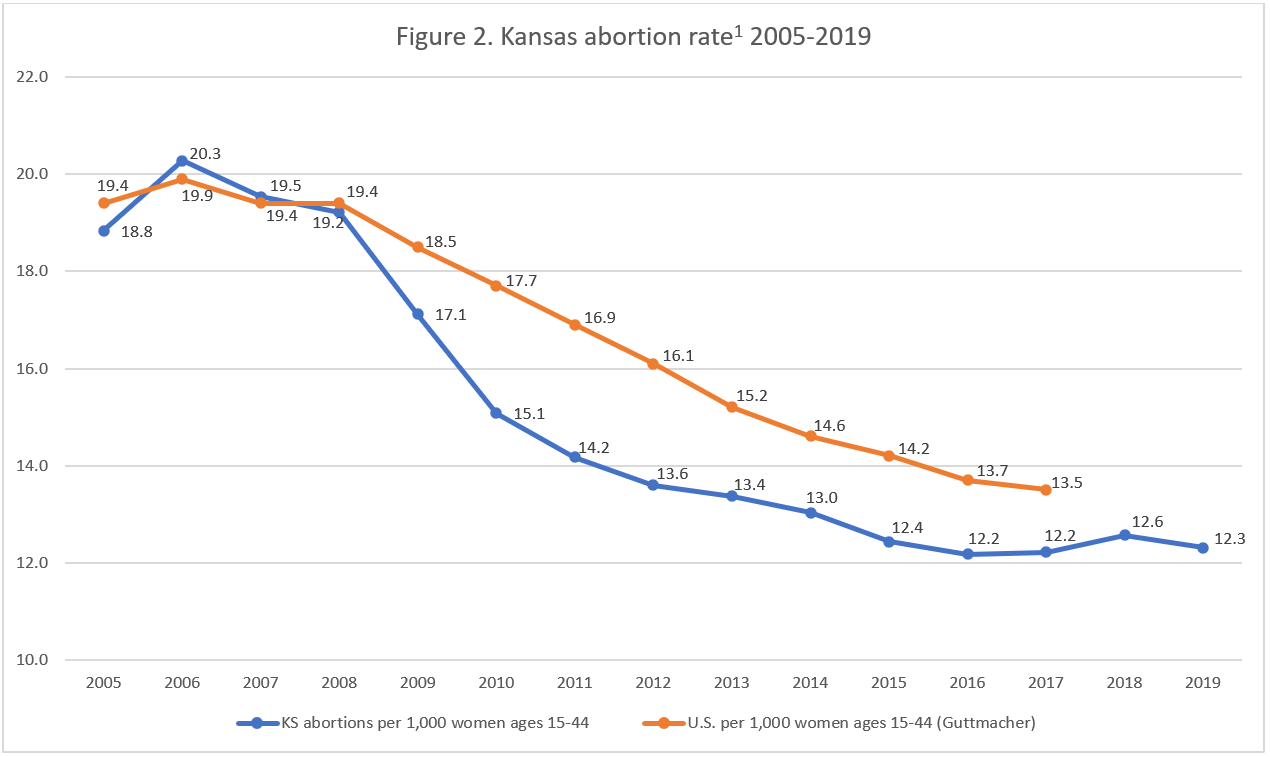Abortion Reporting: Kansas (2019)

Kansas published its preliminary 2019 abortion statistics in June 2020 and released the final report in October 2020. The report shows that after increasing in 2018, abortions declined in 2019.
Changes in Kansas Abortions, 2018-2019

Information on Planned Parenthood’s Kansas abortion market share is not included in the abortion report.
Abortion Totals and Trends
Kansas reported 6,916 abortions in 2019, down two percent from 2018 (Fig. 1). At the same time, chemical abortions increased by three percent, making up 64 percent of all Kansas abortions in 2019. Kansas continues to report a large number of abortions performed on nonresident women. The Charlotte Lozier Institute (CLI) estimates that Kansas’ abortion rate was 12.3 abortions per 1,000 women ages 15 to 44 in 2019, slightly lower than the national rate (Fig. 2).
State Report Summary
In 2019, just 51 percent of the abortions reported in Kansas were performed on state residents, while 49 percent were performed on women from other states. Of these, the vast majority (46 percent of all Kansas abortions) were on women from Missouri. Additionally, there were 22 abortions performed on Kansas women who went out of state for abortions; these 22 abortions are included in the Kansas total. Kansas does not indicate which states report abortions on Kansas residents back to the Kansas Department of Health and Environment. However, three of Kansas’ neighboring states (Colorado, Nebraska, and Oklahoma) together reported 77 abortions on Kansas residents in 2019, suggesting that not all states share abortion data with Kansas.
Women in their early twenties accounted for more abortions than any other age group (31 percent). Twenty-eight percent of the abortions were performed on women ages 25 to 29, 18 percent on women ages 30 to 34, and 10 percent on women ages 35 to 39. Nine percent of Kansas abortions were performed on girls under the age of 20, including two percent on minor girls under the age of 18. Three percent were on women age 40 or older. In Kansas, physicians who encounter minors who are victims of abuse or neglect must report it, and in 2019, 19 abortion reporting forms indicated that such reports had been filed.
Over half the abortions, 54 percent, were performed on non-Hispanic white women, while almost a quarter (24 percent) were on non-Hispanic black women. Four percent were on non-Hispanic Asian or Pacific Islander women, one percent on non-Hispanic American Indian women, and three percent on non-Hispanic women of other races. Fifteen percent of the abortions were performed on Hispanic women. CLI estimates that in 2019, Kansas’ black abortion rate of 41.1 abortions per 1,000 women ages 15 to 44 was 4.5 times the white rate of 9.1. However, due to the large numbers of nonresident women traveling to Kansas for abortions, abortion rates for just Kansas residents were much lower: 4.6 for non-Hispanic white Kansans and 15.7 for non-Hispanic black Kansas women.
Fifteen percent of Kansas abortions were performed on married women, while 84 percent were on unmarried women and not quite one percent were on women whose marital status was not reported. Seventy percent of Kansas abortions were performed on women with at least one previous pregnancy. Twenty-one percent had one prior abortion, and 11 percent had more than one, while 25 percent had one living child and 35 percent had two or more children. Nineteen percent had previously had a miscarriage.
In 2019, the majority of Kansas abortions (64 percent) were chemical abortions induced with mifepristone. Thirty percent were performed using suction curettage, and six percent were dilation and evacuation or dismemberment abortions. There were six sharp curettage abortions, five digoxin/ induction abortions (in which the unborn baby is killed using a lethal injection and then delivered), and four abortions performed using some other means.
A large percentage of Kansas abortions (70 percent) occurred earlier than nine weeks of gestation. A fifth were performed between nine and 12 weeks, six percent between 13 and 16 weeks, and three percent between 17 and 21 weeks of gestation. Zero abortions were reported at 22 weeks or later. Kansas limits abortion at 22 weeks of gestation, when unborn babies can feel pain. Ultrasound was used to determine the length of pregnancy for almost all (6,902) abortions. For one abortion, the date of the women’s last menstrual period (LMP) was used, and for another abortion, both ultrasound and LMP were used. The method of determining gestational age was not reported for 12 abortions.
Late-Term Abortion in Kansas
For decades, Kansas was a magnet for late-term abortions, with hundreds of post-20-week abortions reported every year. Before performing an abortion at 22 weeks or later, doctors had to determine whether the unborn baby was viable. If viable, abortion was only permitted in cases in which a second physician agreed that there was a risk to the woman’s life or a major bodily function. However, “major bodily function” included both physical and mental health.
In 1998, Kansas implemented new reporting standards and restrictions on late-term abortions and partial-birth abortions in particular, and records indicate that many abortions after viability were performed for mental health reasons. Between July 1, 1998, when the new reporting requirements went into effect, and September 30, 1999, 240 partial-birth abortions were reported in Kansas. All of these were performed on babies that were likely viable, and all were performed under the mental health exception. Kansas’ late-term abortion provider stopped performing partial-birth abortions in 1999, and no partial-birth abortions have been reported in the state since October 1999.
In 2011, Kansas enacted its current law limiting abortion at 20 weeks post-fertilization (22 weeks of gestation), unless the mother’s life or a major physical bodily function is in danger.
In 2019, though, the Kansas Supreme Court overturned a law prohibiting dismemberment abortions and in doing so discovered a right to abortion in the Kansas Constitution. The Kansas Senate passed a constitutional amendment to put on the ballot to clarify that the Kansas Constitution does not contain a right to abortion, but the amendment fell four votes short in the House, putting many of Kansas’ pro-life protections, including its late-term abortion limits, at risk. In the 2021 session, the Kansas legislature successfully placed the amendment on the ballot, with both the Kansas House of Representatives and Senate passing it following the election of new pro-life legislators.
State Ranking
A CLI survey of abortion reporting across the country identified Kansas as one of the better reporting states, ranking the state as tied for 15th best. Still, Kansas has room for improvement. Particularly since Kansas has a high volume of chemical abortions, which have a higher complication rate than surgical abortions, Kansas could collect and report data on complications resulting from abortion. Kansas could also report the states to which Kansas residents travel for abortions.


- Rates were calculated by CLI using population estimates from the United States Census Bureau. The rates were calculated using the following formula: (total number of abortions reported by Kansas ÷ number of resident women ages 15-44) x 1,000. Rates may differ slightly from previous CLI articles due to revised population estimates.
























